Overview
- Brief Narrative
- Ceramic wall sculpture juxtaposing boxcars and the stripes of a concentration camp uniform created by Daisy Brand to evoke her ordeal of being imprisoned in multiple concentration camps from 1944-1945. Daisy's art became infused with her Holocaust experience in the 1980s. Her references are suggestive and deliberately ambiguous and she keeps the exact meaning of the symbolism in her work private, thus more evocative and universal. Daisy and her family lived in Chust, Hungary, when it was occupied by the Germans in March 1944. By May, Daisy and her family were deported to Auschwitz-Birkenau death camp. Her father went directly to the gas chamber. Daisy, aged 15, her sister, Mary, aged 19, and her mother, Aranka, aged 39, were selected as forced labor for Kaiserwald concentration camp. In July 1944, the camp was evacuated as Soviet and American forces approached. Aranka disappeared during the forced march. Daisy and Mary were transferred to multiple concentration camps: Dondagen II, Libau, Stutthof, and Buchenwald. On April 17, Buchenwald was evacuated; camp inmates began a forced march to Dachau. They were freed by American forces near Wurzen, Germany, on April 24, 1945. In mid-May, Daisy and her sister were repatriated to their native city, Bratislava, in Czechoslovakia. With the help of the Red Cross, they found an aunt and uncle who took in the girls. This couple, and one other aunt, were their only relatives to survive the Holocaust.
- Artwork Title
- Relocation to the East
- Date
-
creation:
2005
depiction: 1944 May-1945 April
- Geography
-
creation:
Boston (Mass.)
depiction: concentration camp transport;
- Credit Line
- United States Holocaust Memorial Museum Collection, Gift of Daisy Brand
- Markings
- back, bottom right on white label, printed on computer in black ink : 5. Daisy Brand / RELOCATION TO THE EAST/ stoneware & porcelain/ 27”x20 1/2”x3”
- Signature
- back, bottom right below white label, black marker on wood : D. Brand #164
- Contributor
-
Artist:
Daisy Brand
Subject: Daisy Brand
- Biography
-
Daisy Schweiger was born in Bratislava, Czechoslovakia, on September 24, 1929, to Aranka, born in 1905, and Ludwig Schweiger, born 1896. She had an older sister, Mary, born on November 3, 1936. Ludwig was a bank director. Her mother had attended finishing school in Vienna where she studied English, and thus she gave her children English first names. The family was comfortably upper-middle class and assimilated into local culture. They spoke German and Hungarian at home.
In September 1939, the western powers signed the Munich Pact agreeing to the German annexation of the Sudetenland in Czechoslovakia in exchange for a pledge of peace from Hitler. Not long after this, with the support of Nazi Germany, Hungary and Poland annexed adjacent regions as well. The bank where Ludwig worked transferred him to a small branch in Chust (Huszt, Ukraine), a region annexed by Hungary. The Schweigers became Hungarian citizens. Anti-Jewish laws were introduced gradually, but by 1942, Jews were stripped of their rights and forced out of many professions. Ludwig lost his job at the bank, and many of the family’s possessions were sold to support the family. In March 1944, Germany occupied Hungary. All Jews were interned in ghettos and soon the Germans began systematic deportations of the Jewish population to concentration camps. In May, Daisy and her family were taken from the Jewish ghetto to the Auschwitz-Birkenau death camp, arriving on June 7. Her father was immediately sent to the gas chamber. Daisy, her mother, Aranka, and her sister, Mary, were transferred to Birkenau. After three weeks, they were among a group of women selected by Josef Mengele for forced labor in a different camp. That night, they were locked in a concrete building just outside the barbed wire fence, not far from the railway tracks. There were no windows in the room, just a few small glass panels near the ceiling. The women were crammed in, standing room only. The next morning when they were on their way to the train, other prisoners told them that they were lucky to be alive, since the place in which they had been held was a gas chamber, and the order to kill them had been prepared, pending the arrival of the train. They were taken to Kaiserwald concentration camp, near Riga, Latvia, arriving in early July. They lived in a dilapidated stone building with a large courtyard and slept two to a bed on wooden bunks infested with bed bugs. After about a week, a selection took place to send forced laborers to a different work camp. Daisy, Mary, and their mother were able to stay together. They went by boat across the Bay of Riga to Dundaga (Dondangen) and after about a month, were transferred to Dondangen II where they worked in a forest, gathering tree branches for airplane camouflage and shoveling gravel for military construction. Aranka collapsed and was put in the sick bay barracks. In July 1944, as Soviet and American forces advanced into Germany, the prisoners were forced on a death march as the camp was evacuated. Aranka and a few others too ill to walk were pulled by other inmates on a cart. The cart also contained provisions, and once, when the girls passed the cart, their mother managed to sneak them a stolen loaf of bread. One morning, the girls went to check on their mother, but she and the other sick women had disappeared from the cart, replaced by other sick people. They tried to ask the guards about it and where told: "Hau ab" - get lost. They never saw their mother again.
The next stop was Libau, where they were kept in an open field, then loaded onto a train for Stutthof concentration camp, around August 20, 1944. Daisy remembers Stutthof as a gruesome place. The graveled road they marched to the camp was made of broken Jewish tombstones; the Hebrew lettering still visible. There were endless roll calls, beatings, and starvation. After a week, they were transferred to a labor camp in Leipzig, a sub-camp of Buchenwald, where they were leased to an Algemeine Electrische Geselschaft (AEG)-owned airplane factory. Conditions there were much better, but food rations got smaller over time. In March 1945, the factory closed because of Allied bombings. On April 17, the camp was evacuated and the prisoners started on a march towards Dachau. The guards wanted to be captured by the Americans, rather than the Soviets, so they disobeyed orders and led the prisoners towards the Americans. On April 24, 1945, they encountered a US military tank near Wurzen. The Americans disarmed the guards and told the prisoners that they were free.
The prisoners were housed in a box factory and supplied with food. The town was taken over by the Soviet Army, designated as part their postwar sector. Soon a train transport to return the prisoners to their homelands was organized. In mid-May 1945, Daisy and Mary returned to Bratislava. With the help of the Red Cross, they found an aunt and uncle, who had survived the camps, and they took in the sisters. They learned that except for one other aunt, their family had been murdered. Daisy’s paternal grandfather, Maximilian Schweiger, 78 years old and paralyzed, had been taken by stretcher to the train for Auschwitz.
Daisy returned to school and her sister got a job in a Jewish orphanage. In 1948, Daisy met Frederic Brand, born August 6, 1930, in Hlovoves, a medical student in Prague, who had survived the war hiding in the woods with his brother, Maximilian. His parents, Isidor and Rosalia, and his two sisters, Valerie and Helen, were killed on arrival in Auschwitz in 1942. The brothers were helped by a forest ranger, who believed that saving Jews was his obligation as a good Christian. In 1949, Daisy and Frederic, now married, emigrated to Israel. Mary emigrated there as a member of the Haganah and served for two years with the Israel Air Force. She married a Canadian in 1956, settled in Toronto, and had two sons.
Daisy’s husband received his medical degree in Jerusalem and the couple had two sons. In 1966, they emigrated to the US. In 2002, Daisy met a Latvian Jewish survivor, Margers Westermanis, who had been one of the prisoners pulling a cart holding sick women during the march from Dondagen II. He told them that around noon on the day their mother disappeared, the guards took the sick women behind some bushes and shot them. Daisy attended the Museum of Fine Arts school in Boston in the 1960s. She became a well-known artist whose ceramic and mixed-media pieces based on her experiences during the Holocaust have been exhibited internationally. Her husband passed away, age 74 years, in 2004.
Physical Details
- Language
- English
- Classification
-
Art
- Category
-
Sculpture
- Object Type
-
Ceramic sculpture (lcsh)
- Physical Description
- Mixed media sculpture depicting pieces of a prisoner uniform, a boxcar, and a number. It is constructed of 2 multi-colored, irregularly shaped, ceramic metal-textured pieces with painted images, attached to a wood backing. A diagonal line separates the work from the lower left to the upper right corners. An incised line creates a border around the piece. Near the top, a curved, red, square ceramic bar is set above black and white stripes wrapped around a vertical tube. At the top right corner is a tube with the number 6744 painted in white. Under the horizontal tube and to the right of the stripe, another section of rectangular ceramic is attached with a painted image of box cars on a railroad track; people are visible through an open doorway. The artist's signature is incised in the bottom right corner.
- Dimensions
- overall: Height: 28.000 inches (71.12 cm) | Width: 20.250 inches (51.435 cm) | Depth: 3.375 inches (8.573 cm)
- Materials
- overall : stoneware, porcelain, wood, pigment, wire, adhesive, paper, ink, pressure-sensitive tape
Rights & Restrictions
- Conditions on Access
- No restrictions on access
- Conditions on Use
- Restrictions on use
Keywords & Subjects
Administrative Notes
- Legal Status
- Permanent Collection
- Provenance
- The sculpture was donated to the United States Holocaust Memorial Museum in 2009 by Daisy Brand.
- Record last modified:
- 2022-07-28 17:50:22
- This page:
- https://collections.ushmm.org/search/catalog/irn42649
Download & Licensing
In-Person Research
- By Appointment
- Request 21 Days in Advance of Visit
- Plan a Research Visit
- Request to See This Object
Contact Us
Also in Daisy Brand collection
The collection consists of prewar photographs and postwar sculptures created by Daisy Schweiger Brand relating to her experiences of life of pre and postwar Czechoslovakia and in Auschwitz-Birkenau, Kaiserwald, Dondagen II, Libau, Stutthof, and Buchenwald concentration camps during the Holocaust.
Date: 1902-2004
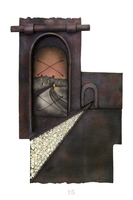
Mixed media wall sculpture by Daisy Brand depicting graveled train tracks entering a concentration camp
Object
Ceramic wall sculpture showing train tracks entering a concentration camp created by Daisy Brand to evoke her ordeal of being imprisoned in multiple concentration camps from 1944-1945. Daisy's art became infused with her Holocaust experience in the 1980s. Her references are suggestive and deliberately ambiguous and she keeps the exact meaning of the symbolism in her work private, thus more evocative and universal. Daisy and her family lived in Chust, Hungary, when it was occupied by the Germans in March 1944. By May, Daisy and her family were deported to Auschwitz-Birkenau death camp. Her father went directly to the gas chamber. Daisy, age 15, her sister, Mary, age 19, and her mother, Aranka, age 39, were selected as forced labor for Kaiserwald. In July 1944, that camp was evacuated as Soviet and American forces approached. Aranka disappeared during the death march. Daisy and Mary then were transferred to multiple concentration camps: Dondagen II, Libau, Stutthof, and Buchenwald. On April 17, Buchenwald was evacuated and the inmates began a forced march to Dachau. They were freed by American forces near Wurzen, Germany, on April 24, 1945. In mid-May, Daisy and Mary were repatriated to their native city, Bratislava, in Czechoslovakia. With the help of the Red Cross, they found an aunt and uncle who took in the girls. This couple, and one other aunt, were their only relatives to survive the Holocaust.
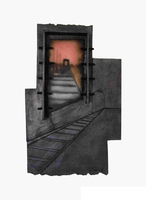
Mixed media wall sculpture by Daisy Brand depicting arrival at a concentration camp
Object
Ceramic wall sculpture showing 2 sets of train tracks entering camp gates created by Daisy Brand to evoke her ordeal of being imprisoned in multiple concentration camps from 1944-1945. Daisy's art became infused with her Holocaust experience in the 1980s. Her references are suggestive and deliberately ambiguous and she keeps the exact meaning of the symbolism in her work private, thus more evocative and universal. Daisy and her family lived in Chust, Hungary, when it was occupied by the Germans in March 1944. By May, Daisy and her family were deported to Auschwitz-Birkenau death camp. Her father went directly to the gas chamber. Daisy, aged 15, her sister, Mary, aged 19, and her mother, Aranka, aged 39, were selected as forced labor for Kaiserwald concentration camp. In July 1944, the camp was evacuated as Soviet and American forces approached. Aranka disappeared during the forced march. Daisy and Mary were transferred to multiple concentration camps: Dondagen II, Libau, Stutthof, and Buchenwald. On April 17, Buchenwald was evacuated; camp inmates began a forced march to Dachau. They were freed by American forces near Wurzen, Germany, on April 24, 1945. In mid-May, Daisy and her sister were repatriated to their native city, Bratislava, in Czechoslovakia. With the help of the Red Cross, they found an aunt and uncle who took in the girls. This couple, and one other aunt, were their only relatives to survive the Holocaust.
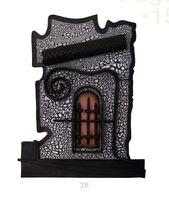
Mixed media wall sculpture by Daisy Brand depicting an iron barred concentration camp prison
Object
Ceramic wall sculpture of an iron barred prison created by Daisy Brand to evoke her ordeal of being imprisoned in multiple concentration camps from 1944-1945. Daisy's art became infused with her Holocaust experience in the 1980s. Her references are suggestive and deliberately ambiguous and she keeps the exact meaning of the symbolism in her work private, thus more evocative and universal. Daisy and her family lived in Chust, Hungary, when it was occupied by the Germans in March 1944. By May, Daisy and her family were deported to Auschwitz-Birkenau death camp. Her father went directly to the gas chamber. Daisy, aged 15, her sister, Mary, aged 19, and her mother, Aranka, aged 39, were selected as forced labor for Kaiserwald concentration camp. In July 1944, the camp was evacuated as Soviet and American forces approached. Aranka disappeared during the forced march. Daisy and Mary were transferred to multiple concentration camps: Dondagen II, Libau, Stutthof, and Buchenwald. On April 17, Buchenwald was evacuated; camp inmates began a forced march to Dachau. They were freed by American forces near Wurzen, Germany, on April 24, 1945. In mid-May, Daisy and her sister were repatriated to their native city, Bratislava, in Czechoslovakia. With the help of the Red Cross, they found an aunt and uncle who took in the girls. This couple, and one other aunt, were their only relatives to survive the Holocaust.
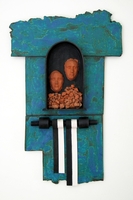
Mixed media wall sculpture by Daisy Brand mourning the cremation of her father at Auschwitz
Object
Ceramic wall sculpture created by Daisy Brand to express her grief over her father's cremation at Auschwitz after being murdered in the gas chamber. Daisy's art became infused with her Holocaust experience in the 1980s. Her references are suggestive and deliberately ambiguous and she keeps the exact meaning of the symbolism in her work private, thus more evocative and universal. Daisy and her family lived in Chust, Hungary, when it was occupied by the Germans in March 1944. By May, Daisy and her family were deported to Auschwitz-Birkenau death camp. Her father went directly to the gas chamber. Daisy, aged 15, her sister, Mary, aged 19, and her mother, Aranka, aged 39, were selected as forced labor for Kaiserwald concentration camp. In July 1944, the camp was evacuated as Soviet and American forces approached. Aranka disappeared during the forced march. Daisy and Mary were transferred to multiple concentration camps: Dondagen II, Libau, Stutthof, and Buchenwald. On April 17, Buchenwald was evacuated; camp inmates began a forced march to Dachau. They were freed by American forces near Wurzen, Germany, on April 24, 1945. In mid-May, Daisy and her sister were repatriated to their native city, Bratislava, in Czechoslovakia. With the help of the Red Cross, they found an aunt and uncle who took in the girls. This couple, and one other aunt, were their only relatives to survive the Holocaust.
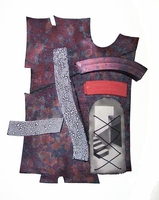
Mixed media wall sculpture by Daisy Brand based on memories of her overnight stay in a gas chamber
Object
Ceramic wall sculpture of stairs descening into an underground chamber created by Daisy Brand to evoke her ordeal of being imprisoned in multiple concentration camps from 1944-1945. Daisy's art became infused with her Holocaust experience in the 1980s. Her references are suggestive and deliberately ambiguous and she keeps the exact meaning of the symbolism in her work private, thus more evocative and universal. Daisy and her family lived in Chust, Hungary, when it was occupied by the Germans in March 1944. By May, Daisy and her family were deported to Auschwitz-Birkenau death camp. Her father went directly to the gas chamber. Daisy, aged 15, her sister, Mary, aged 19, and her mother, Aranka, aged 39, were selected as forced labor for Kaiserwald concentration camp. In July 1944, the camp was evacuated as Soviet and American forces approached. Aranka disappeared during the forced march. Daisy and Mary were transferred to multiple concentration camps: Dondagen II, Libau, Stutthof, and Buchenwald. On April 17, Buchenwald was evacuated; camp inmates began a forced march to Dachau. They were freed by American forces near Wurzen, Germany, on April 24, 1945. In mid-May, Daisy and her sister were repatriated to their native city, Bratislava, in Czechoslovakia. With the help of the Red Cross, they found an aunt and uncle who took in the girls. This couple, and one other aunt, were their only relatives to survive the Holocaust.
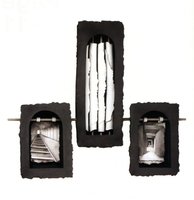
Mixed media wall sculpture in three sections by Daisy Brand memorializing the betrayal and destruction of Jewish culture and religious faith during the Holocaust
Object
Three part ceramic wall sculpture depicting Torah scrolls, train tracks, and a remote chamber created by Daisy Brand to evoke her ordeal of being imprisoned in multiple concentration camps from 1944-1945. Daisy's art became infused with her Holocaust experience in the 1980s. Her references are suggestive and deliberately ambiguous and she keeps the exact meaning of the symbolism in her work private, thus more evocative and universal. Daisy and her family lived in Chust, Hungary, when it was occupied by the Germans in March 1944. By May, Daisy and her family were deported to Auschwitz-Birkenau death camp. Her father went directly to the gas chamber. Daisy, aged 15, her sister, Mary, aged 19, and her mother, Aranka, aged 39, were selected as forced labor for Kaiserwald concentration camp. In July 1944, the camp was evacuated as Soviet and American forces approached. Aranka disappeared during the forced march. Daisy and Mary were transferred to multiple concentration camps: Dondagen II, Libau, Stutthof, and Buchenwald. On April 17, Buchenwald was evacuated; camp inmates began a forced march to Dachau. They were freed by American forces near Wurzen, Germany, on April 24, 1945. In mid-May, Daisy and her sister were repatriated to their native city, Bratislava, in Czechoslovakia. With the help of the Red Cross, they found an aunt and uncle who took in the girls. This couple, and one other aunt, were their only relatives to survive the Holocaust.
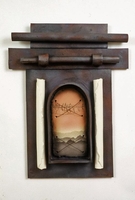
Mixed media wall sculpture by Daisy Brand evoking cherished memories of the her childhood
Object
Ceramic wall sculpture of a faraway landscape viewed through wire created by Daisy Brand to evoke her happy childhood in Czechoslovakia and Hungary. Daisy's art became infused with her Holocaust experience in the 1980s. Her references are suggestive and deliberately ambiguous and she keeps the exact meaning of the symbolism in her work private, thus more evocative and universal. Daisy and her family lived in Chust, Hungary, when it was occupied by the Germans in March 1944. By May, Daisy and her family were deported to Auschwitz-Birkenau death camp. Her father went directly to the gas chamber. Daisy, aged 15, her sister, Mary, aged 19, and her mother, Aranka, aged 39, were selected as forced labor for Kaiserwald concentration camp. In July 1944, the camp was evacuated as Soviet and American forces approached. Aranka disappeared during the forced march. Daisy and Mary were transferred to multiple concentration camps: Dondagen II, Libau, Stutthof, and Buchenwald. On April 17, Buchenwald was evacuated; camp inmates began a forced march to Dachau. They were freed by American forces near Wurzen, Germany, on April 24, 1945. In mid-May, Daisy and her sister were repatriated to their native city, Bratislava, in Czechoslovakia. With the help of the Red Cross, they found an aunt and uncle who took in the girls. This couple, and one other aunt, were their only relatives to survive the Holocaust.
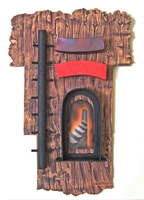
Mixed media wall sculpture by Daisy Brand evoking her memories of arrival at a concentration camp and the crematoria
Object
Ceramic wall sculpture with steps and iron bars created by Daisy Brand to evoke her ordeal of being imprisoned in multiple concentration camps from 1944-1945. Daisy's art became infused with her Holocaust experience in the 1980s. Her references are suggestive and deliberately ambiguous and she keeps the exact meaning of the symbolism in her work private, thus more evocative and universal. Daisy and her family lived in Chust, Hungary, when it was occupied by the Germans in March 1944. By May, Daisy and her family were deported to Auschwitz-Birkenau death camp. Her father went directly to the gas chamber. Daisy, aged 15, her sister, Mary, aged 19, and her mother, Aranka, aged 39, were selected as forced labor for Kaiserwald concentration camp. In July 1944, the camp was evacuated as Soviet and American forces approached. Aranka disappeared during the forced march. Daisy and Mary were transferred to multiple concentration camps: Dondagen II, Libau, Stutthof, and Buchenwald. On April 17, Buchenwald was evacuated; camp inmates began a forced march to Dachau. They were freed by American forces near Wurzen, Germany, on April 24, 1945. In mid-May, Daisy and her sister were repatriated to their native city, Bratislava, in Czechoslovakia. With the help of the Red Cross, they found an aunt and uncle who took in the girls. This couple, and one other aunt, were their only relatives to survive the Holocaust.
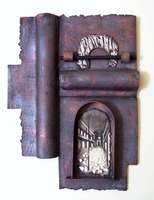
Mixed media wall sculpture by Daisy Brand memorializing the destruction of Jewish culture during the Holocaust
Object
Ceramic wall sculpture showing rubble within a temple created by Daisy Brand to evoke her ordeal of being imprisoned in multiple concentration camps from 1944-1945. Daisy's art became infused with her Holocaust experience in the 1980s. Her references are suggestive and deliberately ambiguous and she keeps the exact meaning of the symbolism in her work private, thus more evocative and universal. Daisy and her family lived in Chust, Hungary, when it was occupied by the Germans in March 1944. By May, Daisy and her family were deported to Auschwitz-Birkenau death camp. Her father went directly to the gas chamber. Daisy, aged 15, her sister, Mary, aged 19, and her mother, Aranka, aged 39, were selected as forced labor for Kaiserwald concentration camp. In July 1944, the camp was evacuated as Soviet and American forces approached. Aranka disappeared during the forced march. Daisy and Mary were transferred to multiple concentration camps: Dondagen II, Libau, Stutthof, and Buchenwald. On April 17, Buchenwald was evacuated; camp inmates began a forced march to Dachau. They were freed by American forces near Wurzen, Germany, on April 24, 1945. In mid-May, Daisy and her sister were repatriated to their native city, Bratislava, in Czechoslovakia. With the help of the Red Cross, they found an aunt and uncle who took in the girls. This couple, and one other aunt, were their only relatives to survive the Holocaust.
Daisy Brand photographs
Document
16 photographs depicting the Schweiger and Fischer families, Daisy Brand's parents' families.



